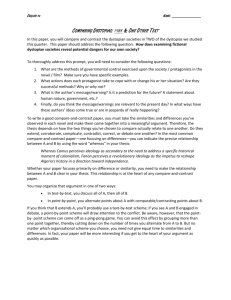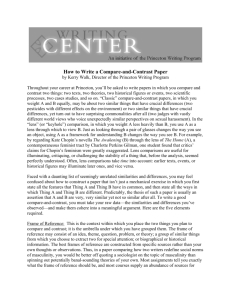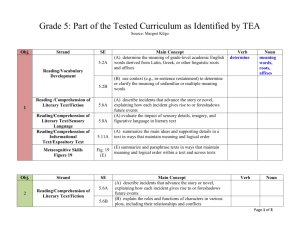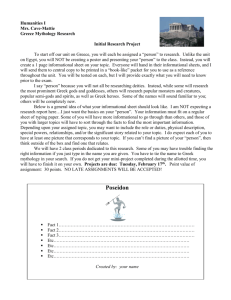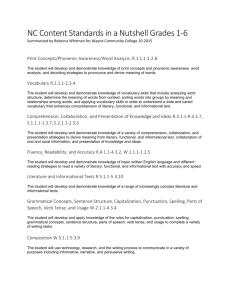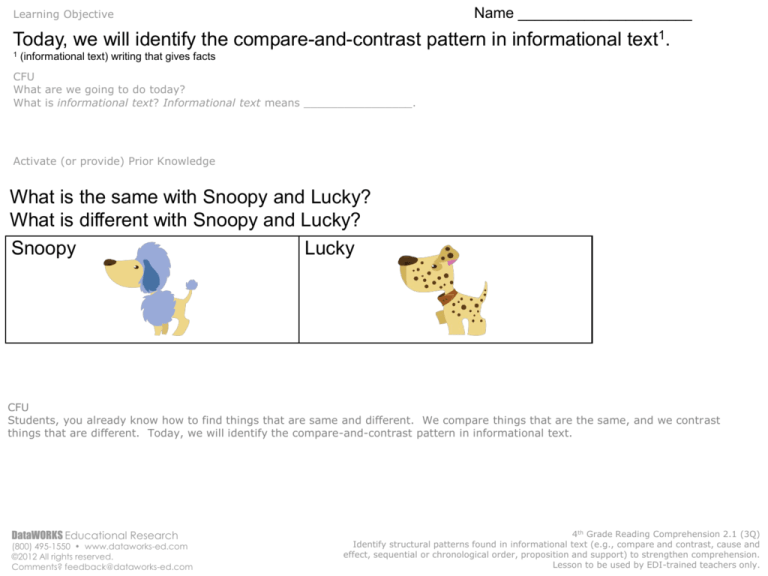
Name _____________________
Learning Objective
Today, we will identify the compare-and-contrast pattern in informational text1.
1
(informational text) writing that gives facts
CFU
What are we going to do today?
What is informational text? Informational text means ________________.
Activate (or provide) Prior Knowledge
What is the same with Snoopy and Lucky?
What is different with Snoopy and Lucky?
Snoopy
Lucky
CFU
Students, you already know how to find things that are same and different. We compare things that are the same, and we contrast
things that are different. Today, we will identify the compare-and-contrast pattern in informational text.
DataWORKS Educational Research
(800) 495-1550 • www.dataworks-ed.com
©2012 All rights reserved.
Comments? feedback@dataworks-ed.com
4th Grade Reading Comprehension 2.1 (3Q)
Identify structural patterns found in informational text (e.g., compare and contrast, cause and
effect, sequential or chronological order, proposition and support) to strengthen comprehension.
Lesson to be used by EDI-trained teachers only.
Concept Development
The compare-and-contrast pattern is writing that tells how two or more things are similar or different.
Compare means to tell how things are similar, the same, or alike.
Contrast means to tell how things are different.
Sometimes compare-and-contrast patterns use clue words:
Compare (similar, alike)
like, likewise, also, too, both, same, similar
Contrast (different)
unlike, different from, but, whereas, on the other hand2
2
(on the other hand) (idiom) means to look at something in a different way
Compare-and-contrast pattern:
1. Frogs and toads both have big mouths and sticky tongues. 2. However, frogs and toads have different
legs. 3. Frogs have long back legs for jumping. 4. Toads have short back legs to hop from one place to
another.
36 words
Not an example of compare-and-contrast pattern:
1. Breakfast is the most important meal of the day. 2. When you eat breakfast, you get the energy you
need for the rest of the day. 3. Kids should always have breakfast in the morning.
33 words
CFU
Which example below is a comparing sentence? How do you know?
Which example below is a contrasting sentence? How do you know?
A. Frogs and toads also lay eggs to have babies.
B. Unlike frogs that have slimy skin, toads have dry skin.
Write one clue word you are not familiar with on your whiteboard.
What is the difference between the example and non-example? Explain your answer.
In your own words, what is a compare-and-contrast pattern? A compare-and-contrast pattern is ______.
DataWORKS Educational Research
(800) 495-1550 • www.dataworks-ed.com
©2012 All rights reserved.
Comments? feedback@dataworks-ed.com
4th Grade Reading Comprehension 2.1 (3Q)
Identify structural patterns found in informational text (e.g., compare and contrast, cause and
effect, sequential or chronological order, proposition and support) to strengthen comprehension.
Lesson to be used by EDI-trained teachers only.
Skill Development/Guided Practice
The compare-and-contrast pattern is writing that tells how two or more things are similar or different.
Compare (similar, alike)
like, likewise, also, too, both, same, similar
Contrast (different)
unlike, different from, but, whereas, on the other hand
Identify the compare-and-contrast pattern in informational text.
Step #1: Read the passage carefully
a: Identify3 the two things being compared, if any. (circle)
b. Identify the compare-and-contrast clue words, if any. (underline)
Step #2: Identify if the informational text is written in the compare-and-contrast pattern. (circle Yes or No)
Step #3: Justify4 your answer. “The text is/is not compare-and-contrast pattern because ______________________.”
3
4
find (synonym)
explain (synonym)
1. Spiders and insects both have an exoskeleton5. 2. Insects have three body segments6, whereas spiders have only two
body segments. 3. Insects have six legs. 4. Spiders, on the other hand, have eight legs. 5. Both spiders and insects have joints7
in their legs, so they can bend them.
5
hard outer body
parts divided into sections
7 places where two bones meet
6
45 words
Compare-and-contrast text?
Yes
No
1. Apples and bananas are both fruit. 2. Bananas are long and yellow, whereas apples are round and can be red, green, or
yellow. 3. Also, apples and bananas grow on trees. 4. Apples have larger brown seeds but bananas have smaller black seeds.
40 words
Compare-and-contrast text?
Yes
No
CFU
(#1a) How did I/you identify what two things were being compared?
(#1b) How did I/you identify the compare-and-contrast clue words?
(#2) How did I/you determine the compare-and-contrast pattern?
(#3) How did I/you justify my/your answer?
DataWORKS Educational Research
(800) 495-1550 • www.dataworks-ed.com
©2012 All rights reserved.
Comments? feedback@dataworks-ed.com
4th Grade Reading Comprehension 2.1 (3Q)
Identify structural patterns found in informational text (e.g., compare and contrast, cause and
effect, sequential or chronological order, proposition and support) to strengthen comprehension.
Lesson to be used by EDI-trained teachers only.
Skill Development/Guided Practice (continued)
The compare-and-contrast pattern is writing that tells how two or more things are similar or different.
Compare (similar, alike)
like, likewise, also, too, both, same, similar
Contrast (different)
unlike, different from, but, whereas, on the other hand
Identify the compare-and-contrast pattern in informational text.
Step #1: Read the passage carefully
a: Identify the two things being compared, if any. (circle)
b. Identify the compare-and-contrast clue words, if any. (underline)
Step #2: Identify if the informational text is written in the compare-and-contrast pattern. (circle Yes or No)
Step #3: Justify your answer. “The text is/is not compare-and-contrast pattern because ______________________.”
1. Birds are animals that have feathers. 2. They mainly live in trees and bushes. 3. Birds lay eggs in the nests that they build
and raise their young until they are old enough to fly. 4. Birds eat seeds, worms, and small insects. 5. There are hundreds of
different types of birds, each with their own song.
53 words
Compare-and-contrast text?
Yes
No
1. The first movie theater, or “picture house,” was built in 1896 and admission was only three cents. 2. By 1905, the first
Nickelodeon movie theatre was built, and admission was five cents. 3. You could watch a 10-minute film called The Great Train
Robbery there. 4. The first full length movie wasn’t shown until 1913.
52 words
Compare-and-contrast text?
Yes
No
CFU
(#1a) How did I/you identify what two things were being compared?
(#1b) How did I/you identify the compare-and-contrast clue words?
(#2) How did I/you determine the compare-and-contrast pattern?
(#3) How did I/you justify my/your answer?
DataWORKS Educational Research
(800) 495-1550 • www.dataworks-ed.com
©2012 All rights reserved.
Comments? feedback@dataworks-ed.com
4th Grade Reading Comprehension 2.1 (3Q)
Identify structural patterns found in informational text (e.g., compare and contrast, cause and
effect, sequential or chronological order, proposition and support) to strengthen comprehension.
Lesson to be used by EDI-trained teachers only.
Relevance
The compare-and-contrast pattern is writing that tells how two or more things are similar or different.
1. Identifying the compare-and-contrast pattern in informational text will help you
better understand text that tells how things are the same or different.
Tornadoes and hurricanes are both very violent storms. Tornadoes are storms that
form on land, different from hurricanes that form over water.
2. Identifying the compare-and-contrast pattern in informational
text will help you do well on tests.
CFU
Does anyone else have another reason why is it relevant to identify the compare-and-contrast pattern in informational text? (pair-share)
Why is it relevant to identify the compare-and-contrast pattern in informational text? You may give me one of my reasons or one of your
own. Which reason is more relevant to you? Why?
DataWORKS Educational Research
(800) 495-1550 • www.dataworks-ed.com
©2012 All rights reserved.
Comments? feedback@dataworks-ed.com
4th Grade Reading Comprehension 2.1 (3Q)
Identify structural patterns found in informational text (e.g., compare and contrast, cause and
effect, sequential or chronological order, proposition and support) to strengthen comprehension.
Lesson to be used by EDI-trained teachers only.
The compare-and-contrast pattern is writing that tells how two or more things are similar or different.
Compare (similar, alike)
Contrast (different)
like, likewise, also, too, both, same, similar
unlike, different from, but, whereas, on the other hand
Skill Closure
Identify the compare-and-contrast pattern in informational text.
Step #1: Read the passage carefully
a: Identify the two things being compared, if any. (circle)
b. Identify the compare-and-contrast clue words, if any. (underline)
Step #2: Identify if the informational text is written in the compare-and-contrast pattern. (circle Yes or No)
Step #3: Justify your answer. “The text is/is not compare-and-contrast pattern because ______.”
1. Dogs and cats are animals. 2. They both have four legs and a tail. 3. Dogs bark, but cats meow. 4. Dogs and cats also need food and water
to live. 5. Dogs need people to provide them with food and shelter, whereas cats can hunt and live on their own.
47 words
Compare-and-contrast text?
Yes
No
1. A lake is a big body of water. 2. Most lakes have fresh water in them. 3. People like to go to the lake to fish, swim, or ride in a boat.
4. The water for lakes comes from the melting snow that travels down through the rivers.
45 words
Compare-and-contrast text?
Yes
No
Constructed Response Closure
Why is the passage below NOT a compare-and-contrast pattern? Explain your answer.
1. A blacksmith is a person who makes and repairs things made of metal. 2. A blacksmith makes and fixes
metal by heating the metal over a hot flame. 3. A blacksmith makes and fixes things like horseshoes and tools.
___________________________________________________________________________________________________
Summary Closure
What did you learn today about identifying the compare-and-contrast pattern in informational text?
Day 1 ________________________________________________________________________________________________
Day 2 ________________________________________________________________________________________________
DataWORKS Educational Research
(800) 495-1550 • www.dataworks-ed.com
©2012 All rights reserved.
Comments? feedback@dataworks-ed.com
4th Grade Reading Comprehension 2.1 (3Q)
Identify structural patterns found in informational text (e.g., compare and contrast, cause and
effect, sequential or chronological order, proposition and support) to strengthen comprehension.
Lesson to be used by EDI-trained teachers only.
Name _____________________
Independent Practice
The compare-and-contrast pattern is writing that tells how two or more things are similar or different.
Compare (similar, alike)
Contrast (different)
like, likewise, also, too, both, same, similar
unlike, different from, but, whereas, on the other hand
Identify the compare-and-contrast pattern in informational text.
Step #1: Read the passage carefully
a: Identify the two things being compared, if any. (circle)
b. Identify the compare-and-contrast clue words, if any. (underline)
Step #2: Identify if the informational text is written in the compare-and-contrast pattern. (circle Yes or No)
Step #3: Justify your answer. “The text is/is not compare-and-contrast pattern because ______________________.”
1. Basketball and soccer are both sports. 2. Like soccer, basketball is played with a round ball. 3. Soccer is played by
kicking the ball with feet, whereas basketball is played with hands. 4. Soccer is played with 11 players different from basketball
that is played with five players.
45 words
Compare-and-contrast text?
Yes
No
1. Ocean Beach is near San Diego, California. 2. The water is salty, and the sands are beautiful colors of brown. 3. It
stretches out to the horizon1. 4. People like to go surfing and swimming there. 5. The town is small and quiet.
1
where the land or sea seems to meet the sky
39 words
Compare-and-contrast text?
DataWORKS Educational Research
(800) 495-1550 • www.dataworks-ed.com
©2012 All rights reserved.
Comments? feedback@dataworks-ed.com
Yes
No
4th Grade Reading Comprehension 2.1 (3Q)
Identify structural patterns found in informational text (e.g., compare and contrast, cause and
effect, sequential or chronological order, proposition and support) to strengthen comprehension.
Lesson to be used by EDI-trained teachers only.
Independent Practice (continued)
The compare-and-contrast pattern is writing that tells how two or more things are similar or different.
Compare (similar, alike)
Contrast (different)
like, likewise, also, too, both, same, similar
unlike, different from, but, whereas, on the other hand
Identify the compare-and-contrast pattern in informational text.
Step #1: Read the passage carefully
a: Identify the two things being compared, if any. (circle)
b. Identify the compare-and-contrast clue words, if any. (underline)
Step #2: Identify if the informational text is written in the compare-and-contrast pattern. (circle Yes or No)
Step #3: Justify your answer. “The text is/is not compare-and-contrast pattern because ______________________.”
1. The best place to take a vacation is the mountains because there is so much to do. 2. You can go for a dip1 in the lake. 3. You
can also take long hikes2. 4. You can go horseback riding with groups led by experienced people. 5. There are campsites for people to
stay at, or you can go backpacking into the wilderness and camp there.
1
swim (idiom)
2
walks (synonym)
62 words
Compare-and-contrast text?
Yes
No
1. Birds and squirrels both live in trees. 2. Also, birds and squirrels like gardens1. 3. Birds can fly but squirrels can’t.
4. Squirrels walk and run very fast. 5. Birds lay eggs, different from squirrels that have live babies . 6. Unlike birds, which have
feathers, squirrels have fur.
1
area where plants are grown
44 words
Compare-and-contrast text?
DataWORKS Educational Research
(800) 495-1550 • www.dataworks-ed.com
©2012 All rights reserved.
Comments? feedback@dataworks-ed.com
Yes
No
4th Grade Reading Comprehension 2.1 (3Q)
Identify structural patterns found in informational text (e.g., compare and contrast, cause and
effect, sequential or chronological order, proposition and support) to strengthen comprehension.
Lesson to be used by EDI-trained teachers only.
Name ______________________
Periodic Review 1
The compare-and-contrast pattern is writing that tells how two or more things are similar or different.
Compare (similar, alike)
Contrast (different)
like, likewise, also, too, both, same, similar
unlike, different from, but, whereas, on the other hand
Identify the compare-and-contrast pattern in informational text.
Step #1: Read the passage carefully
a: Identify the two things being compared, if any. (circle)
b. Identify the compare-and-contrast clue words, if any. (underline)
Step #2: Identify if the informational text is written in the compare-and-contrast pattern. (circle Yes or No)
Step #3: Justify your answer. “The text is/is not compare-and-contrast pattern because ______________________.”
1. Spring time is when everything starts to grow and bloom. 2. People plant vegetable gardens and flower gardens. 3. The
blossoms on the trees mean there will soon be fruits and nuts ready to eat. 4. There are many newborn animals and birds in the
spring. 5. Many people consider spring time as the time when everything is new again.
56 words
Compare-and-contrast text?
Yes
No
1. Snakes and lizards are both cold-blooded animals whose body temperatures change with their
surroundings1. 2. Likewise, snakes and lizards live in the warmer areas of the world. 3. They have
similar scaly2 skin. 4. However, lizards have legs, but snakes do not.
1
area where something lives or is in
of hard skin
2 pieces
Compare-and-contrast text?
DataWORKS Educational Research
(800) 495-1550 • www.dataworks-ed.com
©2012 All rights reserved.
Comments? feedback@dataworks-ed.com
38 words
Yes
No
4th Grade Reading Comprehension 2.1 (3Q)
Identify structural patterns found in informational text (e.g., compare and contrast, cause and
effect, sequential or chronological order, proposition and support) to strengthen comprehension.
Lesson to be used by EDI-trained teachers only.
Periodic Review 1 (continued)
The compare-and-contrast pattern is writing that tells how two or more things are similar or different.
Compare (similar, alike)
like, likewise, also, too, both, same, similar
Contrast (different)
unlike, different from, but, whereas, on the other hand
Identify the compare-and-contrast pattern in informational text.
Step #1: Read the passage carefully
a: Identify the two things being compared, if any. (circle)
b. Identify the compare-and-contrast clue words, if any. (underline)
Step #2: Identify if the informational text is written in the compare-and-contrast pattern. (circle Yes or No)
Step #3: Justify your answer. “The text is/is not compare-and-contrast pattern because ______________________.”
1. Peaches and nectarines are very similar fruit. 2. The peach is different from the nectarine in that it has fuzz1 on its skin
and does not bruise2 as easily. 3. The nectarine, on the other hand, is juicier. 4. Peaches and nectarines have the same
reddish-orange color and a pit3 in the center of the fruit.
1
hair-like covering
damage
3 seed (synonym)
2
53 words
Compare-and-contrast text?
Yes
No
1. Cats come in many different sizes and colors. 2. Some cats are very large and can weigh up to ten pounds or more.
3. Some cats are very small and may only weigh two or three pounds. 4. There are many different colors of cats like black,
white, or white and orange. 5. Some cats have a mixture1 of colors.
1
blend of two or more different things
56 words
Compare-and-contrast text?
DataWORKS Educational Research
(800) 495-1550 • www.dataworks-ed.com
©2012 All rights reserved.
Comments? feedback@dataworks-ed.com
Yes
No
4th Grade Reading Comprehension 2.1 (3Q)
Identify structural patterns found in informational text (e.g., compare and contrast, cause and
effect, sequential or chronological order, proposition and support) to strengthen comprehension.
Lesson to be used by EDI-trained teachers only.
Name___________________________
Periodic Review 2
The compare-and-contrast pattern is writing that tells how two or more things are similar or different.
Compare (similar, alike)
Contrast (different)
like, likewise, also, too, both, same, similar
unlike, different from, but, whereas, on the other hand
Identify the compare-and-contrast pattern in informational text.
Step #1: Read the passage carefully
a: Identify the two things being compared, if any. (circle)
b. Identify the compare-and-contrast clue words, if any. (underline)
Step #2: Identify if the informational text is written in the compare-and-contrast pattern. (circle Yes or No)
Step #3: Justify your answer. “The text is/is not compare-and-contrast pattern because ______________________.”
1. Pecans and peanuts are both nuts. 2. Pecans grow on trees which is different from peanuts which grow underground.
3. Pecans and peanuts also have shells. 4. They are grown for food too and can be eaten raw or used in cooking. 5. Unlike
pecans that are grown in orchards1, peanuts are grown in fields.
1
large groups of trees
51 words
Compare-and-contrast text?
Yes
No
1. Polar bears live in the snowy, northern regions. 2. They are very big and white. 3. A polar bear’s diet
consists mainly of seals. 4. The polar bear cubs like to play in the snow. 5. Polar bears are considered a
marine1 mammal. 6. Polar bears hibernate or sleep through the winter and give birth to their young during this
time.
1
related to the sea
Compare-and-contrast text?
DataWORKS Educational Research
(800) 495-1550 • www.dataworks-ed.com
©2012 All rights reserved.
Comments? feedback@dataworks-ed.com
54 words
Yes
No
4th Grade Reading Comprehension 2.1 (3Q)
Identify structural patterns found in informational text (e.g., compare and contrast, cause and
effect, sequential or chronological order, proposition and support) to strengthen comprehension.
Lesson to be used by EDI-trained teachers only.
Periodic Review 2 (continued)
The compare-and-contrast pattern is writing that tells how two or more things are similar or different.
Compare (similar, alike)
Contrast (different)
like, likewise, also, too, both, same, similar
unlike, different from, but, whereas, on the other hand
Identify the compare-and-contrast pattern in informational text.
Step #1: Read the passage carefully
a: Identify the two things being compared, if any. (circle)
b. Identify the compare-and-contrast clue words, if any. (underline)
Step #2: Identify if the informational text is written in the compare-and-contrast pattern. (circle Yes or No)
Step #3: Justify your answer. “The text is/is not compare-and-contrast pattern because ______________________.”
1. Paper airplanes are fun to make. 2. There are many different types that can be made. 3. You can make
them in many different shapes and sizes. 4. They can be decorated1 by drawing pictures on them or they can
be made from colored paper. 5. Paper airplanes can be very, very small or very big. 6. They are fun for all
ages.
1
colored, painted
58 words
Compare-and-contrast text?
Yes
No
1. Screws and nails are similar types of fasteners1. 2. Nails are used with a hammer, but you need a
screwdriver to use a screw. 3. Nails are smooth and have no grooves2, different from screws that have grooves
and are rough. 4. Both nails and screws can be used to fasten two pieces of materials together.
1
used to hold two things together
2
thin line cut into a hard surface
Compare-and-contrast text?
DataWORKS Educational Research
(800) 495-1550 • www.dataworks-ed.com
©2012 All rights reserved.
Comments? feedback@dataworks-ed.com
53 words
Yes
No
4th Grade Reading Comprehension 2.1 (3Q)
Identify structural patterns found in informational text (e.g., compare and contrast, cause and
effect, sequential or chronological order, proposition and support) to strengthen comprehension.
Lesson to be used by EDI-trained teachers only.
Name___________________________
Periodic Review 3
The compare-and-contrast pattern is writing that tells how two or more things are similar or different.
Compare (similar, alike)
Contrast (different)
like, likewise, also, too, both, same, similar
unlike, different from, but, whereas, on the other hand
Identify the compare-and-contrast pattern in informational text.
Step #1: Read the passage carefully
a: Identify the two things being compared, if any. (circle)
b. Identify the compare-and-contrast clue words, if any. (underline)
Step #2: Identify if the informational text is written in the compare-and-contrast pattern. (circle Yes or No)
Step #3: Justify your answer. “The text is/is not compare-and-contrast pattern because ______________________.”
1. Reptiles come in many forms. 2. Snakes, lizards, turtles, alligators, and crocodiles are all types of reptiles. 3. Most reptiles are
cold-blooded. 4. They never have fur or feathers. 5. Reptiles typically1 have scales. 6. Reptiles lay eggs and build nests to keep their
eggs in. 7. Most reptiles live in the warmer areas of the world.
1
usually (synonym)
51 words
Compare-and-contrast text?
Yes
No
1. People sometimes confuse turtles and tortoises. 2. They both have shells. 3. Unlike tortoises who are mostly land dwelling1,
many turtles live in the water. 4. Tortoises have short feet with strong bent legs, whereas turtles have webbed feet like a duck with long
claws. 5. Like the tortoise, turtles lay their eggs on land.
1
living
51 words
Compare-and-contrast text?
DataWORKS Educational Research
(800) 495-1550 • www.dataworks-ed.com
©2012 All rights reserved.
Comments? feedback@dataworks-ed.com
Yes
No
4th Grade Reading Comprehension 2.1 (3Q)
Identify structural patterns found in informational text (e.g., compare and contrast, cause and
effect, sequential or chronological order, proposition and support) to strengthen comprehension.
Lesson to be used by EDI-trained teachers only.
Periodic Review 3 (continued)
The compare-and-contrast pattern is writing that tells how two or more things are similar or different.
Compare (similar, alike)
Contrast (different)
like, likewise, also, too, both, same, similar
unlike, different from, but, whereas, on the other hand
Identify the compare-and-contrast pattern in informational text.
Step #1: Read the passage carefully
a: Identify the two things being compared, if any. (circle)
b. Identify the compare-and-contrast clue words, if any. (underline)
Step #2: Identify if the informational text is written in the compare-and-contrast pattern. (circle Yes or No)
Step #3: Justify your answer. “The text is/is not compare-and-contrast pattern because ______________________.”
1. Butterflies and moths are insects. 2. Insects are small animals that have six legs, a body that is divided into three parts,
and sometimes have two pairs of wings. 3. Like butterflies, moths have wings and antennae1. 4. Butterflies hold their wings up
when they land. 5. Moths on the other hand, hold their wings flat. 6. The antennae on a butterfly have little balls on the end,
whereas those on moths do not.
1
two long thin parts on an insects head
74 words
Compare-and-contrast text?
Yes
No
1. The ocean’s coral reefs1 are in danger of being destroyed2 by humans. 2. Every year humans dump trash into the sea
which results in changes to the environment of the coral reef. 3. Due to this pollution3, the ocean is not clean enough for the coral
reef to stay healthy. 4. Therefore, if the oceans keep being polluted, more and more coral reefs will die.
1 (coral
reefs) areas in the ocean that have rocks and plants
damaged so badly that it dies
3 trash
2
62 words
Compare-and-contrast text?
DataWORKS Educational Research
(800) 495-1550 • www.dataworks-ed.com
©2012 All rights reserved.
Comments? feedback@dataworks-ed.com
Yes
No
4th Grade Reading Comprehension 2.1 (3Q)
Identify structural patterns found in informational text (e.g., compare and contrast, cause and
effect, sequential or chronological order, proposition and support) to strengthen comprehension.
Lesson to be used by EDI-trained teachers only.
EDI – Cognitive, Teaching and English Learners Strategies
Learning Objective : Identify the compare-and-contrast pattern in informational text.
Cognitive Strategies
Elaboration
Teaching Strategies
Demonstration
Targeted vocabulary: informational text, compare, contrast, on the other hand, identify, justify, exoskeleton, segments, joints,
Language Strategies
Vocabulary Words
Academic
compare, contrast, identify, justify
Content
informational text, compare, contrast,
Support
on the other hand, exoskeleton, segments, joints
Multiple-Meaning
Vocabulary
Strategy
Synonym
identify (find), justify (explain)
Definition
informational text, compare, contrast, on the other hand, exoskeleton, segments,
joints
Homophone
Internal Context Clue
Listen, Speak
Read
Write
on the other hand = idiom
Similar Sounds
Tracked Reading
Decoding Rules
Writing
Content Access Strategies
Comprehensible
Input
Cognates
Graphic Organizer
Contextual Clues
Contextualized
Definitions
Pictures
Blank Page
DataWORKS Educational Research
(800) 495-1550 • www.dataworks-ed.com
©2011 All rights reserved.
Comments? feedback@dataworks-ed.com
4th Grade Reading Comprehension 2.1 (3Q)
Identify structural patterns found in informational text (e.g., compare and contrast, cause and
effect, sequential or chronological order, proposition and support) to strengthen comprehension.
Lesson to be used by EDI-trained teachers only.

